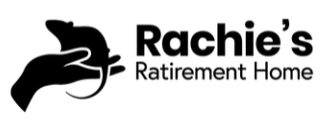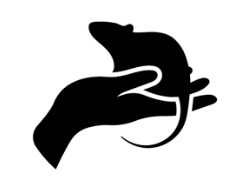Patchwork rats and Entropion
TL;DR: There is a condition common to patchwork rats called entropion, where the eyelids curl or angle inwards so that the eyelashes or eyelid fur scratch against the eyeball.
It can affect the top or bottom eyelid or both, and can be in one or both eyes.
Signs include squinting or inability to open eyes, thickened eyelids, lashes touching the eye, watery eyes, discharge including red/brown porphyrin.
It is usually a product of breeding, people need to learn how to identify and avoid it.
When animals are bred away from their natural ‘wild type’ traits and toward an extreme, issues can arise. We see this in dogs with brachycephalic breeds such as pugs, and in recent years there’s been a push from the wider community for breeders to select away from traits that harm the animals - in some countries it is now illegal to breed from dogs with too short snouts!
This is where patchwork rats are in Australia at the moment, but without the wider community acknowledgement and support (so far).
This is the current knowledge on entropion, hopefully as we learn more I’ll be able to update it, but this is what all owners and suppliers should know.
Entropion can be:
Inherited: Passed from the parents as a genetic trait, and the physical structure of the rat is such that they suffer entropion from a young age, or as they develop. They may also be more prone to induced entropion due to poor eye structure.
Some lines of patchworks have issues only rarely, others are close to 100% of rats.Induced/cicatricial: Eye trauma such as injury or irritation can cause swelling or scar tissue, leading to the eyelids curling or changing angle.
Inherited entropion is a really common issue in the Australian rat community in 2020. Like with dog breeders, there are some exceptional breeders around the country who have put in the time and effort to understand how and why this occurs, and who select away from it and/or only breed from established lines that others have worked on. Even those will occasionally have issues with entropion, but these places are working hard to produce healthy animals.
There are also countless places where patchworks are bred for profit due to their unique aesthetic, and live every day of their lives with the pain and infection risk of constant hair in their eyes, unless an expensive surgery is done by a specialist vet to correct the eyelid shape. It’s at the point in the Brisbane area where it’s common for 100% of the patchworks in a store to have severe entropion at 6 weeks old, and that’s unacceptable.
ALL rat suppliers need to learn about entropion and how to identify it, not only breeders but rescues and pet/produce stores as well. Many breeders have a genuine pride and care for their animals and are happy to learn. But for those that are solely profit driven, community and buyer pressure is often the only way to make a difference, so we need the pet owning community to make educated decisions and create the right kind of demand.
What to know:
Entropion causes a curling of the eyelids which makes the lashes and fur scratch against the eye (trichoma). Trichoma can occur for other reasons as well, like curly double rex eyelashes curling inwards.
Rats can have rounded eyes or almond-shaped rexoid eyes. In both cases, eyes should be bright, clear and fully open. Squinting in rats is a sign of pain.
Rats with thickened, bulgy eyelids may be suffering from entropion. Look very closely for thick eyelids, squinting or inability to open the eye, redness, swelling around the eye, watery eyes, crustiness or discharge including porphyrin, which will be red to reddish brown and may form a crust.
In extreme or progressed cases, you may be able to pull the eyelid back to reveal the eyelashes curled fully underneath the lid, rubbing on the eye.
The only way to fix entropion is via surgical alteration of the affected eyelids. Any owners seeking a patchwork from any source MUST be willing to do this - even good lines and good breeders are not immune to occasional issues or induced entropion.
For breeders: Type issues that MAY contribute are tight skin or muscle on the eyelid - which may be inadequate lid length or eye bulging too far out and pulling the lid, etc. Excess folds of skin and wrinkles pushing against the lids is also a known issue.
For pet shops: Finding a good rat supplier is key to avoiding headaches and not perpetuating unethical practice. We are working on educational sheets for staff and customers, and a guide of questions to ask a supplier. General advice would be to avoid patchworks from ‘walk-ins’ and only buy from people comfortable showing you their setups and the parentage of the litters. A good hint is that breeders who know what they’re doing usually don’t sell earlier than 8 weeks, though some do feel that 6 is acceptable. It may be hard to find a good quality breeder as a pet store, because the impossibility of tracking line health and temperament that pet store selling causes, is opposite to the goals of most ethical breeders. Breeders that charge more for ‘rare’ or unusual coat types are a huge red flag, nothing is rare in animals that breed so prolifically, and this is the definition of attributing value to aesthetic over health.
There is also reason to suspect that even well bred patchworks with good eye structure are also more prone to inducible entropion, because they lack the fur which would naturally keep dust, bacteria and debris away. There are breeders currently investigating the extent to which this plays a part in induced entropion, but following the advice for hairless mice, avoiding shavings and other fine particle substrates may be a good idea, perhaps consider using paper pellet cat litter.
It is really important to treat eye irritation promptly - temporary trichoma from swelling and irritation can progress to true entropion as scar tissue builds. Wiping or flushing eyes with saline and seeking vet advice for managing environmental irritation and inflammation is key.
A healthy rexoid eye shape. Rat eyes can be rounded, or almond shaped like this double rex patchwork. This is not squinting, the eye is clear and bright, and the eyelids aren’t thick. You wouldn't want the eye to be any more ‘closed’ than this. Thanks to Sienna of Poké Rats for the image.
[Image lost in website migration - will update soon!]
A young rat with inherited entropion. Note the squinting and swelling in both eyes, the crust of red porphyrin around the eyes indicating pain or irritation. The right eye is forced completely shut, and the left is also fairly bad. The extent of the swelling varies as inflammation also contributes, but this rat needs corrective surgery to overcome the problem. Photo of Pidge, of Rachie’s Ratirement Home
[Image lost in website migration - will update soon!]
A baby patchwork with inherited entropion, before and after corrective surgery. Thank you to Jae for pictures of foster rat Tess via Rachie’s Ratirement Home
[Image lost in website migration - will update soon!]
Rachie wishes to thank Sienna of Poké Rats, Mel of Pixie Paws Rodentry, Jess of Furbaby Rodentry and Jo of Fairypaws Rodentry for the discussions and shared experiences and research and their input on this piece.

